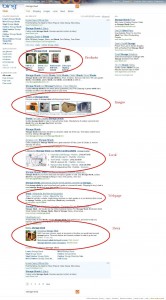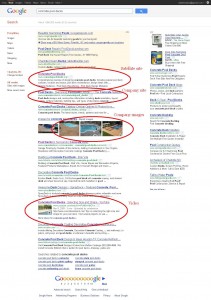Search Marketing: Optimize social media, images, video and everything else
Search engine marketers have based entire careers on improving rankings. They fight tooth and nail to reach the top of the page, win more traffic, and push all their competitors down a notch.
But what if you could get more traffic by pushing your competitors down a few more notches? Or pushing them down on more keywords? By focusing on universal search, you can do just that.
Search engines do not strictly deliver links to webpages anymore. They deliver links to images, videos, products, news and more. This is called “universal search.” Just check out the results from this recent Bing search for “storage shed.”
This page links to five different types of content. If you become a master at creating and search-optimizing this content, then you can claim not just higher rankings — but more rankings.
Here are some key categories of content and tactics pulled from MarketingSherpa research:
Category #1. Images and photos
Websites are loaded with images, particularly if they offer many products or publish daily content. Every image can be optimized to improve its chances at being listed for regular or image-only searches.
Marketers for Skinsight (formerly VisualDxHealth) told us how they experienced a 500% increase in site traffic, 70% of which came from growth in image search. As we described in an article on image optimization, the marketers achieved this by ensuring:
- The site’s more than 2,000 images were easily accessible to search engines
- Each image’s title, file name and alt text were relevant and accurate
- The team patiently waited for results to accumulate
Category #2. Products and product pages
You do not want to forget your standard webpages. Each product or service usually has a unique webpage that can attract targeted, long-tail traffic — if you optimize it.
For example, marketers at Working Person’s Store told us how they created high-quality descriptions for every product on the site. The keyword-rich approach helped turn organic traffic into the company’s primary revenue driver and account for more than 71% of all site traffic at the time.
As described in the case study, the team worked with writers to incorporate the brand’s voice into the descriptions, show off the company’s expertise, and keep the copy conversational and witty. The marketers ensured the copy was search-optimized, and also hired a quality photographer to create product images.
– Product searches
Search engines also feature products in vertical searches, such as in Google’s Product Search. This tool pulls information from data that merchants share with the engine, and its results are often integrated into regular search results, as you can see in the “storage shed” example from earlier. Go to Google’s Merchant Help Center to learn how to get your products included.
Category #3. Video
Natural search is one of the many marketing channels that can benefit from video. Your relevant, useful and well-made films can help capture more research results and traffic.
Even though we wrote the case study back in 2009, marketers at The Concrete Network still dominate page one for “concrete pool decks” in Google. Among the results helping the company own this space is a video on the team’s YouTube page.
The marketers at Concrete Network outlined the following tactics they used to get their videos onto page one at the time (see more in the case study):
- Make useful, relevant videos that are tied to HTML content
- Support video creation with keyword research
- Keep videos professional, short and on topic
- Go deep into a topic with several videos
- Lightly brand the content
Category #4. Local and maps
Search engines feature nearby results for some terms. For example, if I type “marketing agencies” into Google, I am shown general results as well as links to agencies based in Charlotte (which is where I work). If I search for “pizza,” Yahoo! shows me a map of nearby delivery services.
In this how-to article, we hit the key tactics you can use to optimize your local search results. We also featured a case study about a company taking control of its Google Maps result and improving it. Here are some quick best practices to improve your local listings:
- Claim your local business listing with all the major search engines
- Include a local phone number (not 1-800)
- Include a local address
- Optimize your description with keywords
- Associate the listing with all relevant categories
- Add videos, images and/or offers
- Complete every section of requested information for the listing
Category #5. Social media
Let’s not forget the darling of digital marketing: social media. By optimizing your team’s Facebook, Twitter and LinkedIn profiles, they will more likely display for related searches.
In our 2011 Social Marketing Benchmark Report, 76% of marketers agreed that “many natural search listings today are linked to social media content, so the integration of social media and SEO tactics is absolutely essential.”
Below are the percentages of marketers who say social media is somewhat or very effective at achieving specific SEO objectives, according to our 2010 Social Media Marketing Benchmark Report:
- Improving search rankings: 91%
- Increasing traffic from targeted keywords: 90%
- Expanding content shown in universal search results: 89%
- Improving the ROI from search programs: 80%
- Generating more qualified leads: 78%
We outlined seven tactics to help you reap some of these rewards in a two-part special report on social media and SEO last year. It’s a great start to keep all your social media profiles and content relevant to your company and its products.
Optimize routinely and consistently
You can target any one of these categories for an overhaul, but you should avoid turning this into a one-off effort. Our research shows that SEO marketers with thorough guidelines and routine processes have the greatest results.
Search engine optimization benefits from strong architecture, a clear process and steady execution — over and over and over — not a herculean project with a start and stop date.
Related Resources:
Marketing Research Chart: Top SEO objectives
Marketing Research Chart: SEO budgets for 2012
SEO: How to launch a website redesign without hurting search rankings and traffic
SEO: Content-heavy pages can bring search traffic … and search penalties?
Lift Long-Tail Search Traffic: 6 Tactics to Find and Test Niche Content Areas
SEO Research: Why opportunity is knocking for marketers doing SEO
2011 Social Marketing Benchmark Report
SEO Research: Why opportunity is knocking for marketers doing SEO
Categories: Search Marketing images, local search optimization, product searches, search engine optimization, Search Marketing, social media












GREAT post. I think the thing everyone aiming for higher search results should keep in mind is the more content, the better. Videos, maps, web pages, social media…you can’t get found if you’re not present. Thanks for the great tips on optimizing all of these facets!
GREAT post. I think the thing everyone aiming for higher search results should keep in mind is the more content, the better. Videos, maps, web pages, social media…you can’t get found if you’re not present. Thanks for the great tips on optimizing all of these facets!
Excellent post. Our research at Conductor supports the importance of universal search–it found 8 out of 10 high volume keywords had universal search results of some kind: http://www.conductor.com/blog/2011/10/the-changing-face-of-the-serps-8-out-of-10-high-volume-keywords-now-have-universal-results/
Hi Nathan — Thanks for sharing the great research. That results distribution chart is very interesting. It looks like “news” items are displayed twice as often as nearly every other type of search result.
Great post, Adam, with a good breakdown of “how to optimize what” for search. Also thought Nathan’s post was interesting as it relates to SERPs, and LOVE the infographic. Nice to see both posts together and how they relate to universal search. Thanks for the deep dive!
Yup. Things varied too by industry–for example, looking at retail centric keywords, 8 out of 10 keywords had shopping results so it’s important for marketers to understand the specifics of their particular makeup before attacking the SERPs.@Adam T. Sutton